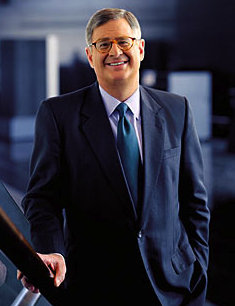This article is more than 1 year old
What do YOU look for in a tech CEO: Smart, sales savvy, his own hair?
From Apotheker to Ballmer - our guide to who's in charge and who should be in charge
A 'driven' CEO will also need a high IQ, foresight and a bit of political knowhow
Professor Andrew Kakabadse of Cranfield University - who is a bit of an expert on what makes a good CEO - reckons companies like Siebel lack the strategic vision and foresight to survive: “Apart from a high IQ and being driven, a CEO needs a strong sense of vision and the practical ability to drive their changes through. They have to be able to see where the market is going and how the financial markets will respond to any changes they initiate. They also need an acute political sense to assess the political implications of any future moves.”
Tom Siebel either didn't foresee the rapidly shifting market dynamics, or wasn't able to respond quickly enough to them, when the market began moving towards hosted CRM and a monthly licence rental model that customers wanted. But that said his grounding in sales did provide the foundation for its original stellar rise. For example, Siebel understood the importance of partners and at one point had over 700 partner alliances.
Certainly HP, in spite of its troubles, understands the value of partnerships and despite making some serious missteps in the past, hasn't lost its focus on the channel. From the partner perspective this bodes well for the company.
Loay Lawrence, sales and commercial director at Vokhus, says: “The channel is confident in a vendor if they understand the routes to market, how products go to market and who is contributing. The route to market has changed from the '90s and while some people complain about it, if resellers and distributors can see that a CEO understands the value of partners they will be on board whatever the CEO’s background is. It's early days for Whitman at HP but she's clever. We have a wait-and-see approach but ultimately we think she'll deliver.”
But even consistency at the board level is no guarantee of future success. Take Sun Microsystems for example. The company was once the belle de jour of the industry. Its product line included servers, workstations, Solaris operating system software for client server networks, its own microprocessors, Java Internet software and enterprise-wide support services. Between 1988 and 1998 its revenues grew on average a nice warm glowing 34 per cent every year. Everyone associated with the company benefited -including the channel. It seemed that Scott McNealy, its CEO, could do no wrong.

But then it started going awry. Sun was concentrating on its existing high-end customers rather than paying attention to the adoption of its core software assets at the low end. For partners this translated to poor marketing practices and a tendency to ignore marginal channel relationships rather than concentrating on developing new business through partners.
At one level it made sense. Most revenues were coming from long-standing customers so the company placed its focus there at the expense of building a new customer base. But this eventually led to its demise. When Scott McNealy handed over the CEO reins to Jonathan Schwartz in 2006, he'd acquired the distinction of being one of the few CEOs of a major corporation to hold onto his position for over 20 years. Perhaps it was this very long-termism that led to a blinkered approach.
Schwartz set about trying to plug the holes in a sinking ship and began a drive to promote the company's Solaris operating system and open source software. Sun also abandoned Solaris on Intel x86 computers, which ultimately undermined the hardware platforms it depended upon as x86 architectures became increasingly popular at the high end.
However, Sun's ultimate demise came from left-field developments: the global financial crisis kicked in during 2007 and with a third of its revenues coming from financial services - and with large customers going bankrupt, being taken over, or otherwise losing control of their IT spending - the firm had little choice but to seek a buyer.
As CEO, and based on Kakabadse's definitions of what makes a good CEO, it’s arguable that Schwartz should have seen the gathering clouds of financial trouble brewing. But very few people did and those who did predict this particular storm were often considered to be mavericks. But it would seem fairly obvious to many people, even the baker down the road, that there is danger in relying on revenues from one source.
Howard Hall, managing director at HP Gold Partner DTP Group, reckons that if a CEO is surrounded by a good and strong team it inevitably inspires confidence in the channel. He concedes that a CEO who provides a clear sense of direction is critical but a competent and able team is just as important in galvanising operations. This also reflects Kakabadse's view that if the board isn't completely behind a CEO then he or she will ultimately fail.
You don't even need to be a techie...
When it comes to CEO stability, two vendors come to mind: Intel and IBM. Both have a history of promoting CEOs from inside who understand the business. However, this is not an exclusive policy. Big Blue's Lou Gerstner came from outside the company and was the first non-IBM lifer to assume the CEO mantle. He'd previously spent time at Nabisco, a manufacturer of cookies and snacks, and American Express. His appointment put paid to the view that tech CEOs need to understand technology. Gerstner made a virtue of his outsider status and was able to use it to positive and radical effect at Big Blue.

Sam Palmisano: From
salesman to president...
Despite its monolithic size, IBM was close to running out of cash when Gerstner took over. His first action was to make it solvent and he then launched a series of initiatives that turned it from inward navel-gazing to focusing on the needs of customers, in the process changing its culture. This in turn benefited the channel as customers, and consequently, partners took on increased importance again.
Gerstner's successor, Sam Palmisano rose through the ranks from salesman to become president of the enterprise systems and personal systems group. He also drove through an enormous change taking truly bold steps to move the company from hardware to software and services. The company's vision has certainly benefited the channel. IBM was familiar with the potential of Big Data before the wider industry knew what it meant. And its focus on cloud has placed partners well ahead of the field when it comes to delivering services.
Intel is another tech giant with a history of CEO stability, grooming its leaders from inside. Paul Otellini, its current CEO, joined the company in 1974 and rose to the heady heights in 2005 when he replaced Craig Barrett. He has overseen some major changes including a headcount cull of 10,500 as part of move to save $3bn a year. However, Otellini is now taking early retirement - something previously unheard of for an Intel CEO.
He tried to take it in a new direction away from its core legacy business of PCs towards mobile computing. Intel created an OEM architecture for Ultrabook thin and light computers, is now making belated moves into the smartphone market and recently acquired software security vendor McAfee in part of a wider drive to position itself as a security expert that fuses software security into the hardware level.

Intel CEO Paul Otellini
But for Otellini it’s too little too late. The PC market is slowing down as smartphones and tablets become more popular and Microsoft, once a strong partner, has introduced WinRT, which runs on ARM-architecture chips. The new Intel CEO will need to measure success in terms of how rapidly it can gain market share in the mobile space. So: a solid sales background and coming up through the ranks is an almost essential attribute of the ideal tech CEO - except when it’s a liability.
If there is one element that a tech CEO requires that can't be taught or acquired and that is luck. It might be argued that Steve Jobs at Apple had luck in bucketloads, er, at least in business. Before the launch of the iPhone Apple was a minor league company but Jobs' vision of how the iPhone should be marketed and manufactured has transformed the company into one of today's leading tech outfits. Jobs had the confidence in his vision and managed to bring together his experience in development with business acumen to create one of the worlds most popular, copied and ubiquitous devices. Contrast this with Microsoft, which in 2002 launched the world's first tablet computer via an OEM design. It went down like a lead balloon tied to a chunk of concrete. Yet here we are in world that is increasingly dominated by tablet computing in all its various guises.
The channel needs a sense of stability from vendors and this is often, but not always, provided by a CEO. Most channel players want a vendor they can rely on and one that understands the importance of channels to market. If a vendor acts from this understanding, the channel will embrace it whether the CEO comes with deep technical expertise or whether they've freshly arrived from a biscuit company. ®
